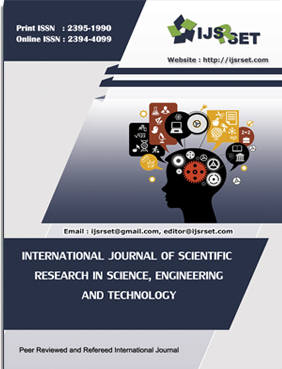Synthesis of Alumina Using Urea and Glycine as Fuel: Mono Fuel Approach
DOI:
https://doi.org/10.32628/IJSRSET25121170Keywords:
Urea, Glycine, alumina, SHS, SynthesisAbstract
In this Paper, “Synthesis of Alumina using urea & Glycine as fuel: Mono fuel approach”, chosen as research work, here two fuel types (urea & glycine) were used in two different experiments, along with aluminium nitrate as oxidizer, to synthesise alumina powder. Three samples for each fuel type were prepared with variation in fuel to oxidizer ratio, in reference to stoichiometric ratio. Samples were further characterized with respect to observation of combustion flame, XRD and SEM analysis. Results obtained are in good agreement with available literature and almost as expected, from application point of view.
📊 Article Downloads
References
Novitskaya E , P. K. James, Bhaduri S. & Graeve Olivia “A review of solution combustion synthesis: an analysis of parameters controlling powder characteristics”, International Materials Reviews, 2020; 66:188-214 DOI: 10.1080/09506608.2020.1765603. DOI: https://doi.org/10.1080/09506608.2020.1765603
Patil Kc, Hegde Ms, Tanu Rattan, Aruna St. “Chemistry of nanocrystallineoxide materials: combustion synthesis, properties and applications”.
Merzhanov AG, Mukasyan AS.” Combustion of solid flame”. Moscow: Torus Press; 2007. 336.
Mukasyan AS, Martirosyan K, “Combustion of heterogeneous systems: fundamentals and applications for material synthesis”. Kerala, India: Transworld Research Network; 2007. 234.
Borisov AA, DE Luca L, Merzhanov AG, editors. “Self-propagating hightemperaturesynthesis of materials.” New York: Taylor and Francis; 2002. 337.
Segadaes AM. “Oxide powder synthesis by the combustion route”.Eur Ceram News Lett 2006; 9:1–5.
Patil KC, Aruna ST, Mimani T. “Combustion synthesis: an update”. Curr Opin Solid State Mater Sci 2002; 6:507–12 DOI: https://doi.org/10.1016/S1359-0286(02)00123-7
Merzhanov AG, Borovinskaya IP, Sytchev AE. “SHS of nano-powders. In: Baumard J-F, editor. Lessons in nanotechnology from traditional materials to advanced ceramics”. Dijon, France: Techna Group Srl; 2005. p. 1–27.
Mukasyan AS, Rogachev AS. “Discrete reaction waves: gasless combustion of solid powder mixtures”. ProgEnerg Comb Sci 2008; 34:377–416.
Filimonov IA, Kidin NI.” High-temperature combustion synthesis: generation of electromagnetic radiation and the effect of external electromagnetic fields”. Comb Explos Shock Waves 2005; 41:639–56. DOI: https://doi.org/10.1007/s10573-005-0078-z
A.S. Mukasyan, A.S. Rogachev, “Discrete reaction waves: gasless combustion of. solid powder mixtures”, Prog Energ Comb Sci, 2008;34: 377–416. DOI: https://doi.org/10.1016/j.pecs.2007.09.002
A Sharma ,O P Modi ,G K Gupta ,” Combustion Synthesis of Nanocrystalline Al2O3 Powder using Aluminium Nitrate and Urea as reactants—influence of reactant composition”, Advances in Applied Science Research, 2012;3 (6):3819-3824.
A Sharma A,OP Modi ,GK Gupta “ Effect of fuel to oxidizer ratio on synthesis of alumina powder using Solution Combustion Technique-Aluminium Nitrate & Glycine combination”, Advances in Applied Science Research, 2012, 3 (4):2151-2158. DOI: https://doi.org/10.1007/s13204-013-0199-8
A Sharma ,A Rani , ASingh ,O.P Modi ,GK Gupta , “Synthesis of alumina powder by the urea–glycine–nitrate combustion process: a mixed fuel approach to nanoscale metal oxides” Appl Nanosci, DOI 10.1007/s13204-013-0199-8.
D. Thomazini, M. V. Gelfuso, Alumina ceramics obtained by chemical synthesis using conventional and microwave sintering Cerâmica 2011;57:45-49, brazil, 1321 DOI: https://doi.org/10.1590/S0366-69132011000100006
K. Wefers, C. Misra, Oxides and Hydroxides of Aluminium, Alcoa Technical Paper No. 19, Alcoa Laboratories, Pittsburgh, PA, 1987.
J. Temuujin, Ts. Jadamba, K.J.D. Mackenzie, P. Angerer, Thermal formation of corundum from aluminium hydroxides prepared from various aluminium salts, Bull. Mater. Sci. 2000;23 (4):301–304. DOI: https://doi.org/10.1007/BF02720086
Rodica ROGOJAN, Ecaterina ANDRONESCU Synthesis and Characterization of alumina nano powder obtained by sol-gel method. U.P.B. Sci. Bull., Series B, Vol. 73, Iss. 2, 2011
R. ROMÁN, T. HERNÁNDEZ, and M. GONZÁLEZ, Nano or micro grained alumina powder? A choose before sintering, Bol. Soc. Esp. Ceram. V., 2008;47, 6:311-318 DOI: https://doi.org/10.3989/cyv.2008.v47.i6.153
T. Meher, A.K. Basu, S. Ghatak, Physicochemical characteristics of alumina gel in hydroxyhydrogel and normal form, Ceramics International 2005; 31:831–838. DOI: https://doi.org/10.1016/j.ceramint.2004.09.011
S. Srikanth, N. Suriyanarayanan, S. Prabahar, V. Balasubramanian, D. Kathirvel, Advances in Applied Science Research, 2011;2 (1):95.
Harith Hasoon Al-Moameri, Zainab Majid Nahi et al. “A review on the biomedical applications of alumina”, Journal of Engineering and Sustainable Development, 2020; 24(05): DOI:10.31272/jeasd.24.5.5 DOI: https://doi.org/10.31272/jeasd.24.5.5
Downloads
Published
Issue
Section
License
Copyright (c) 2025 International Journal of Scientific Research in Science, Engineering and Technology

This work is licensed under a Creative Commons Attribution 4.0 International License.




